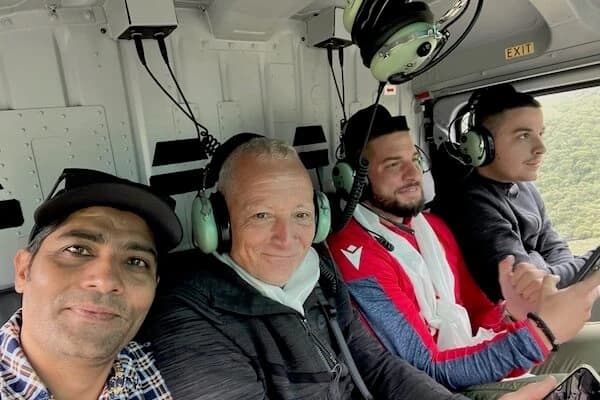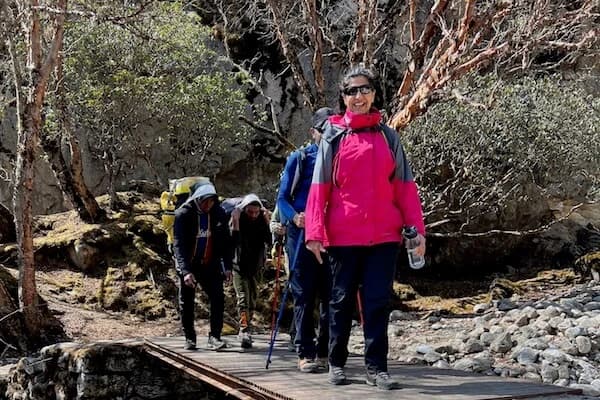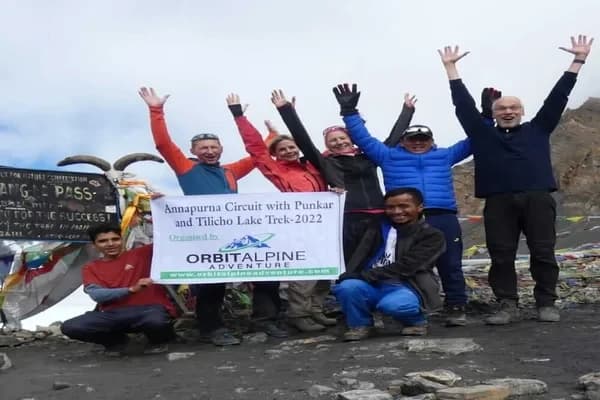The Annapurna Circuit is located in the trans-Himalayan region of Mt. Annapurna and Mt.
Dhaulagiri both of which are above 8,000 meters high. The trekking route covers two river
valleys Marshyangdi and Kali Gandaki and extends up to the Tibetan Plateau. The highest point
of this trekking is Thorung La Pass with an elevation of 5,416 m (17,769 ft). Similarly, you will
go across Tilicho Lake at 4,919 meters (16,138 ft) which is the lake situated at the highest
altitude of the world in Manang district. Next notable site in the Annapurna Circuit Trekking
is Muktinath Temple, a famous Hindu pilgrimage site in Mustang district. You can also
experience the desert-like climate in Manang and Mustang in the trans-Himalayan region.
The rocky trails surrounded by the hills and clustered houses are also matter of interest for you.
You can also have a familiar view about the people and their lifestyle, culture and tradition of the
Himalayas of Nepal. The major peaks that come into your sight during the Annapurna Circuit
Trek are Annapurna Massif (Annapurna I-IV), Machhapuchhre, Manaslu, Gangapurna, Tilicho
Peak, Pisang Peak and Paungda Danda around the journey.
Trekking to the Annapurna Circuit enriches you with the familiarity with the mountains view
and a variety of flora and fauna and diverse types of human settlement areas in the Himalayas.
During the trekking through the Annapurna Circuit, you come into contact with the climatic
variation from subtropical of alpine. And of course, distinction in vegetation, wildlife and socio-
cultural aspects of the region. Annapurna Circuit Trek is one amongst the many worldwidely
appreciated trekking routes and in Nepal, it comes second just after the Everest Base Camp Trek.
The trek begins from Beshisahar of Lamjung district and ends at Nayapul, Pokhara, Kaski.
Daywise Itinerary
Day 01: Arrival in Kathmandu (1,350m/4,429ft)
When your plan is landed at Tribhuvan International Airport, Kathmandu, the mediator of the
travel agency which has organized your trip, will receive you there. Then, he/she will lead you
up to the hotel or lodge for your accommodation for the night. You can taste the food items and
take rest as much as you require because you may have travel sickness.
Day 02: Valley Sightseeing and Preparing for the Trek
Today, you can spend your day by travelling around the Kathmandu Valley which is known
as the ‘city of temples’ as well. Here you can find some of the historical, cultural and religious
sites enlisted into the UNESCO World Heritage Site on different dates. Some of them are
Hanuman Dhoka Durbbar Square, Patan Durbar Square, Bhaktapur Durbar Square, Pahupatinath
Temple, Changunarayan temple, Swayambhunath Stupa and Bouddhanath Stupa. After you
return to the hotel, your facilitator will give you specific briefing about the trekking like sites to
go across, important landscapes, gear, climate and so on.
Day 03: Drive to Beshisahar (760m/2,493ft) to Khundi (790m/2,592ft)


Today, you will leave Kathmanu Valley for reaching the starting point of the action packed
trekking package to the Annapurna Circuit. It takes almost 7 hours drive to reach Khundi from
Kathamandu. From Nagdhunga height, you can enjoy the enchanting scrutiny of the landscapes
full of trees and houses while driving downwards Naubise, Dhading. As soon as you reach
Galchhi, you will be driven along with the flow of the water in the Trishuli River until you reach
Motel Du Mugling of Chitwan.
By crossing the first Arch Bridge in the country inaugurated by this year, you reach Tanahun
which is famous for Siddha Gufa (Siddha Cave) which is said to the largest in Asia. Then, your
road diverts towards right side from Dumre by leaving Prithvi Highway. Now, you will be going
along the bank of the Marshyangdi River that has originated from a place under Annapurna
Circuit Trek route. From Khundi, you catch glimpse of the Manaslu range.
Day 04: Trek to Jagat (1,300m/4,265ft)
This is the first day of your Annapurna Circuit Trekking. Feel a little high morally and
commited to complete the task and gather the most invaluable experience handy in life! While
walking towards Jagat from Khundi, you will be going along the bank of the Marshyangdi River
as if to find its origin! The natural settings and inhabited areas with typical Nepalese style houses
around the rocky trail are the major attraction for the travelers towards Annapurna Circuit. You
spend the night here at a teahouse for the rest and proceed the journey the following morning.
Day 05: Trek to Dharapani (1,860m/6,102ft)

You start your journey early in the morning so that you feel little comfortable to walk along the
undulating path sometimes ups and the other times down. You have to walk across the grassy
land, rocky trail by crossing some suspension bridges on the way. After a while, you will enter
into the magnificent valley of Manang district. On the way, you can see the agricultural practices
of the people living in the Himalayan highland. Though the soil there lacks a good deal of
productivity, we find barley, potatoes, corns and sheds for cattle suitable in the high altitude.
You can also enjoy the gorgeous sight of rhododendrons and bamboo forests around the place.
Day 06: Trek to Chame (2,670m/8,759ft)
On this day, you will trek from Dharapani to Chame, the administrative headquarters of Manang
district, for the night stay. The trail passes along the steep ridges where we can see a number of
landslides due to geographical complexities and development of roadway to Manang Mustang.
On the way, you can see a very clear and close view of Lamjung Himal, Annapurna II and
Annapurna IV. Several natural and charming waterfalls around the Dudh Khola and the
Marshyangdi River help you forget the difficulties faced during the journey. You have to walk
past Bagarchhap Village with Bhotiya residents dwelling in there. The most striking aspect of
this village is the sight of the Buddhist prayer flags on top of the traditional houses in the
Himalayan region.
Day 07: Trek to Upper Pisang (3,300m/10,826ft)
Next day, you set off for reaching Upper Pisang (before Lower Pisang used to be the station for
night stay) for spending that night. On the way, you go past Bhartang located in the steep and
narrow valley. The way further leads you through dense pine and oak forests on both the sides.
In Pisang, you can find good hotels and lodges are available serving you with typical Nepali and
continental cuisines of your choice and appetite.
Day 08: Trek to Manang (3,540m/11,614ft)

On this day, you trek to Manang, one of the major villages in the district. There are two gateways
to reach Manang. If you follow the southern side, you catch sight of the Annapurna Massif
whereas if you go through the northern part, you can have the picturesque outlook of mysterious
Mustang district. The choice is yours after all! You can visit Barge Monastery which is the
largest of this kind in the district. In Manang village, you can find an airstrip, many lodges and a
checkpoint for security purpose. You can spend the night at the lodge of your booking or choice
if any. The climate of Manang is colder and drier than that of the stations you sheltered before.
Day 9: Acclimatization in Manang
As the climate of Manang is quite colder and drier due to high altitude, you need to be
acclimatized by spending a day here for your better health. For the purpose, you can go across
the Marshyandi River to reach Gangapurna Lake by walking for about half an hour.
From hereyou can have a 360-degree panoramic vision of the Annapurna Massif and neighbouring
mountains dressed in white snow. The nearby meadow just like Yak Kharka is another focal
point of the site. If you are strong enough, in best of your health and eager to walk a short distance for about 2.5
hours, Ice Lake can be the best destination. The Ice Lake Trail to the east of Manang leads you to
Chulu East or Far East. There at an elevation of 4,650m (15,256ft) you can find a group of lakes
named Kicho Tal (‘Tal’ means ‘lake’ in Nepali language). The lakes are formed by the snow
coming down from various ridges of Chulu East peak that separate Chulu Khola in the east and
Ghatte Khola to the west.
Day 10: Trek to Yak Kharka (4,050m/13,287ft)

‘Kharka’ in Nepali means ‘meadow for cattle like yak, sheep, etc. grazing’. Today, you are going
to reach Yak Kharka to rest for the night. Today you will enter into the Jarsang Khola Valley
crossing the Marshyangdi River Valley and Manang. On the way upwards, you pass a village
Tengi which is typical in appearance, styles of houses, culture and tradition. Since this region lies
in the Alpine altitude, the vegetation and wildlife found in here are quite distinct. The major
vegetations found here are juniper and alpine grasses which can grow in this height. Your
journey although hard will be more remarkable with the majestic prospect of Gangapurna and
Annapurna II peaks. By completing the rocky trail, now you reach Yak Kharka where many
hotels and lodges are waiting for your services of night stay and food items.
Day 11: Trek to Thorang Phedi (4,525m/14,845ft)
Today, you are trekking up to Thorang Phedi for the night station so that you can easily reach
the highest point of the Annapurna Circuit Trek, Thorang La. You will go a little upwards
following the banks of the Jarsang Khola which hurriedly runs to find its destination. You reach
Thorang Phedi (‘Phedi’ means the plain land at the bottom of a foot hill) by crossing a village
named Letdar. You can find the lodges and hotels at Thorang Phedi which are almost occupied
with various groups of trekkers from various countries and local travel companies in Nepal. You
can enjoy the meal and good rest here for further ascent the following day.
Day 12: Trek to Thorang La (5,416m/ 17,769ft) to Muktinath (3,760m/12,335ft)
.jpeg)
This day is the most memorable and important because you will be at the highest altitude point
of the Annapurna Circuit Trek, Thorang La at the elevation of 17,769 ft. ‘La’ in local dialect
means the ‘Pass’ to enter or exit into or from a landscape to the other. You are advised to ascend
slowly and steadily by reminding ‘Slow and steady wins the race!’ because you are going on top
of the circuit trail. You will see the pass bejeweled by the prayer flags to mark the importance
and following of Buddhism. After resting for a while to feel the captivating scenery of the
Annapurna Massif and the snowcapped mountains around it. From this top, you come to see the
eyecatching Kali Gandaki Valley in front of you.
Then, you start descending towards Muktinath region. Muktinath is famous for Muktinath
Temple at the height of 3,800m and is supposed to be a sacred shrine for Hindus and Buddhists
pilgrims. On the way, you can have a wonderful sight of Mt. Dhaulagiri and Tukuche Peak. You
forget all the tiredness and troubles felt and faced during the trekking when you remind the view
of the Himalayan giants on the way to Muktinath. There you can find a lot of hotels and lodges
with good facilities of your choice. You can relish the food items found here and have a good
rest here.
Day 13: Trek to Marpha (2,670m/8,759ft)
On this day, you are climbing down to Marpha Village which is famous for apple production.
The experiment of the apple production was done here in the initial days and extended to other
Himalyan regions in the northen part of Nepal. To reach Marpha, you will walk across Jomsom,
the administrative headquarters of Mustang district. For your information, Jomsom is the
windiest valley in the trail and rainshadowed part of the region. Jomsom has a domestic airport
from where you can fly to Pokhara or Kathmandu. Since it has road link to Pokhara through
Beni, Myagdi, you can travel by bus if you want to shorten your trekking. To reach Jomsom, you
will go across two villages named Jharkot and Khingar which are built in Tibetan architectural
style.
You begin your journey through the mystic Kali Gandaki valley by passing the parched
countryside of the alpine climatic region. You will be walking through the region where the
world’s deepest gorge the Kali Gandaki Gorge is located. You will walk following the banks of
the Kali Gandaki River by enjoying the blissful scene of Nilgiri peaks.
Marpha is a beautiful Thakali village located in Mustang. ‘Thakali’ is the derivative word from
‘Thak Khola’ lying in the upper part of the Kali Gandaki River in the Mustang Valley. Later on
the people dwelling around the Thak Khola (‘Khola’ means a stream in Nepali language) started
to be called ‘Thakali’. Thakali Kitchen serving the typical Nepali food items is popular and set
up in almost all parts of Nepal.
The design of Marpha village is very fantastic that it has a complete modern drainage and
sewage system with the stone paved streets that adds to the beauty of the village. Marpha is
famous for apple orchards and apple products like apple cider, peach, apricot and apple liquor
called ‘Marpha’. The brandy liquor made up of apples is transported throughout the country and
even out of the country. You can taste the apple products found in the village and take a
complete relaxation that night.
Day 14: Trek to Kalopani (2,530m/8,300ft)
Your destination for the day is Kalopani of Mustang district. The trekking this day is also quite
challenging but full of fun and happiness as you have to pass some suspension bridges set up
above the Kali Gandaki River. You can also sight the wonderful mountains, trees, villages and
meadows as if they were welcoming you for a glimpse of themselves! You will see the
welcoming view of the mountain peaks like Annapurna I, Dhaulagiri, three Nilgiris and Fang.
On the way, you go past some villages like Tukuche, Kobang, Lartjung, Kokhethanti and
Dhampu which provide you a golden opportunity to experience the architect, socio-cultural
aspects and lifestyle of the people living in the High Himalayas. They are really unique and
appealing to the travelers from around the world! You have to climb up and down the river beds
to reach the destination. There are some fine lodges in the station where you can eat up your food
and take rest at night for further descent the following day.
Day 15: Trek to Tatopani (1,190m/3,904ft)
Today you are scheduled to cross the distance between Kalopani and Tatopani. You will descend
through the Rukse Chhahara (‘Chhahara’ means ‘spring’) situated between Annapurna I and
Dhaulagiri I opposite to each other. After that, you will pass through various human settlement
areas with scant houses and population. To reach Tatopani, you will trek through Ghasa village
which is the last Thakali village in the Annapurna Circuit Trek. The Tibetan architectural design
reflecting Buddhist religious aspect is used to make the houses and other construction materials
for human settlement. Ghasa is popular for bird watching and marijuana for the lovers of those
things.
Tatopani is the Nepalese term given to the natural hot waterfall made out of the Kali Gandaki
River. The folks believe that if you take a bath with natural hot water, you can get your skin
diseases of any kind cured. You can take a holy bath in the waterfall and recover from some skin
diseases if any! And most importantly, you can feel relaxed for rest of the time there after the
bath.
Day 16: Trek to Ghorepani (2,880m/9,448ft)
Today, you will reach up to Ghorepani for the night hang out. Initially, the way goes down
through the slope until for an hour. The villages like Shikha and Ghara are really beautiful places
to feel the invaluable taste of Mother Nature. Then, you will walk past some villages like Phalate
and Chitre in which people of different castes and creeds with their own type of socio-cultural
aspects and lifestyle. And next interesting fact about these villages is that most of the men here
are involved in British and Indian Army for employment purpose! On the way, you can feel the
appealing charm of Mt. Dhaulagiri and Annapurna ranges.
On the way, a small foot hill, you will walk across the rhododendron forests where you can even
watch various species of monkeys and birds. Although it is quite earlier of the day and you can
measure more length of the path, you had better stay here for a specific reason. The reason is that
next morning you can make a short walk to Poon Hill, another well-known touristic center in the
region.
Day 17: Trek to Tadapani (2,630m/8,628)
You will start the day with a short trip to Poon Hill early in the morning so that you can enjoy
the sun rising and the heart-touching outlook of the snowcapped mountains in the region. Poon
Hill is a short walk from Ghorepani for the breathtaking view of the Dhaulagiri I-IV, Tukuche
Peak, Dhampus Peak, Nulgiri range, Annapurna and Barha Shikhar (group of twelve peaks also
known as French Fang), Annapurna south, Fishtail, Mardi and Himchuli. The scene you
experience from this foot hill top is the best view in your life. So, don’t miss it!
After having breakfast here, you will move forward to Tadapani, another station for the night
settlement. On the way to Tadapani, you will come to contact with the dense forests of
rhododendron, bamboo and oak trees. Similarly, in the course of trekking, you will regularly
come to see waterfalls, hard rocks, distinct species of native animals and birds sheltered in the
green terrain. You now are in Tadapani, a small but beautiful village that offers you a really
magnificent appearance of Annapurna south, Himchuli, Fishtail and Annapurna II. You will
spend the night at a tea house by tasting the food items available here and sleep well for the next
day’s challenge.
Day 18: Trek to Ghandruk (1,940m/6,364ft) to Pokhara (820m/2,690ft)\
Today is the last day of your Annapurna Circuit Trekking. Your destination is Pokhara, ‘the city
of lakes’ and the most important and famous touristic destination of Nepal. Early in the morning
you will head towards Ghandruk by walking across forests of a variety of species of
rhododendron where you can observe local species of birds and other Himalayan wildlife. On the
way, you can see some river gorges, too. Different species of rhododendrons make your trekking
colourful while varieties of species of the wildlife make your trip quite live and memorable.
Ghandruk is a typical Gurung (one of the major ethnic community of Nepal) village where you
can experience the typical culture, social setting, food items of the Gurung people who serve
mostly in British or Indian Army for livelihood. From here, you can have a lifetime achievement
by looking into the picturesque vision of the mountains under the Annapurna Range. Other sites
to visit in Ghandruk are Gurung Museum and old Ghandruk town itself.
From Ghandruk, you can take a vehicle directly to reach Pokhara if you are fed up of walking. In
case, you still have the courage and strength in you, you can walk down to Nayapul through
Birethanti. You have to walk across many villages on the way to Nayapul. From here, you can go
either by a public means of transportation or you can hire a vehicle for your comfort. You can
choose any hotel, lodge or resort for your night rest. You can visit this city of lakes with all
amenities of global standard. Today, you have accomplished the most challenging and
fascinating the Annapurna Circuit trekking package. And, you can celebrate this achievement
with your mates for making it more lifelong memorable!
Day 19: Drive back to Kathmandu
Today, you can visit Pokhara city for more fun and major sites of the city. Or, you can drive to
Kathmandu. You take a complete rest for the remaining time or you can even make it a time for
fête for the triumph! The choice is yours after all!
Day 20: Departure or Plan Further
Today, the mediator of the travel agency will follow you until Tribhuvan International Airport
(TIA) for the final see off. As welcoming and farewell is a wonderfully respectful sense of
hospitality in Nepalese culture. Or, in case you desire to extend your visa or stay, we would love
to help with all required arrangements here in the Himalayan country!






.jpeg)




